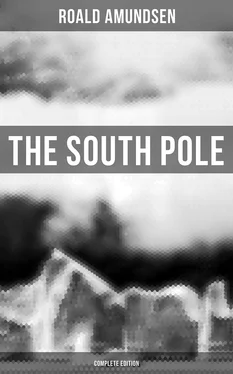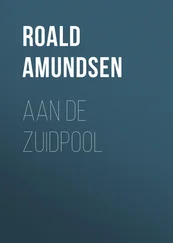Roald Amundsen
The South Pole
(Complete Edition)
Published by

Books
- Advanced Digital Solutions & High-Quality eBook Formatting -
musaicumbooks@okpublishing.info
2018 OK Publishing
ISBN 978-80-272-4918-3
The First Account
Introduction
Chapter I The History of the South Pole2
Chapter II Plan and Preparations
Chapter III On the Way to the South
Chapter IV From Madeira to the Barrier
Chapter V On the Barrier
Chapter VI Depot Journeys
Chapter VII Preparing for Winter
Chapter VIII A Day at Framheim
Chapter IX The End of the Winter
Chapter X The Start for the Pole
Chapter XI Through the Mountains
Chapter XII At the Pole
Chapter XIII The Return to Framheim
Chapter XIV Northward
Chapter XV The Eastern Sledge Journey
Chapter XVI The Voyage of the “Fram”
Appendix I The “Fram”
Appendix II Remarks on the Meteorological Observations at Framheim
Appendix III Geology
Appendix IV The Astronomical Observations at the Pole
Appendix V Oceanography
To
My Comrades,
The Brave Little Band That Promised
In Funchal Roads
To Stand by Me in the Struggle for the
South Pole,
I Dedicate this Book.
Roald Amundsen.
Uranienborg,
August 15, 1912.
Table of Contents
On February 10, 1911, we started for the South to establish depots, and continued our journey until April 11. We formed three depots and stored in them 3 tons of provisions, including 22 hundredweight of seal meat. As there were no landmarks, we had to indicate the position of our depots by flags, which were posted at a distance of about four miles to the east and west. The first barrier afforded the best going, and was specially adapted for dog-sledging. Thus, on February 15 we did sixty-two miles with sledges. Each sledge weighed 660 pounds, and we had six dogs for each. The upper barrier (“barrier surface”) was smooth and even. There were a few crevasses here and there, but we only found them dangerous at one or two points. The barrier went in long, regular undulations. The weather was very favourable, with calms or light winds. The lowest temperature at this station was — 49° F., which was taken on March 4.
When we returned to winter quarters on February 5 from a first trip, we found that the Fram had already left us. With joy and pride we heard from those who had stayed behind that our gallant captain had succeeded in sailing her farther south than any former ship. So the good old Fram has shown the flag of Norway both farthest north and farthest south. The most southerly latitude reached by the Fram was 78° 41’.
Before the winter set in we had 60 tons of seal meat in our winter quarters; this was enough for ourselves and our 110 dogs. We had built eight kennels and a number of connecting tents and snow huts. When we had provided for the dogs, we thought of ourselves. Our little hut was almost entirely covered with snow. Not till the middle of April did we decide to adopt artificial light in the hut. This we did with the help of a Lux lamp of 200 candle-power, which gave an excellent light and kept the indoor temperature at about 68° F. throughout the winter. The ventilation was very satisfactory, and we got sufficient fresh air. The hut was directly connected with the house in which we had our workshop, larder, storeroom, and cellar, besides a single bathroom and observatory. Thus we had everything within doors and easily got at, in case the weather should be so cold and stormy that we could not venture out.
The sun left us on April 22, and we did not see it again for four months. We spent the winter in altering our whole equipment, which our depot journeys had shown to be too heavy and clumsy for the smooth barrier surface. At the same time we carried out all the scientific work for which there was opportunity. We made a number of surprising meteorological observations. There was very little snow, in spite of there being open water in the neighbourhood. We had expected to observe higher temperatures in the course of the winter, but the thermometer remained very low. During five months temperatures were observed varying between — 58° and — 74° F. We had the lowest (-74° F.) on August 13; the weather was calm. On August 1 we had — 72° F. with a wind of thirteen miles an hour. The mean temperature for the year was — 15° F. We expected blizzard after blizzard, but had only two moderate storms. We made many excellent observations of the aurora australis in all parts of the heavens. Our bill of health was the best possible throughout the whole winter. When the sun returned on August 24 it shone upon men who were healthy in mind and body, and ready to begin the task that lay before them.
We had brought the sledges the day before to the starting-point of the southern journey. At the beginning of September the temperature rose, and it was decided to commence the journey. On September 8 a party of eight men set out, with seven sledges and ninety dogs, provisioned for ninety days. The surface was excellent, and the temperature not so bad as it might have been. But on the following day we saw that we had started too early. The temperature then fell, and remained for some days between — 58° and — 75° F. Personally we did not suffer at all, as we had good fur clothing, but with the dogs it was another matter. They grew lanker and lanker every day, and we soon saw that they would not be able to stand it in the long run. At our depot in lat. 80° we agreed to turn back and await the arrival of spring. After having stored our provisions, we returned to the hut. Excepting the loss of a few dogs and one or two frostbitten heels, all was well. It was not till the middle of October that the spring began in earnest. Seals and birds were sighted. The temperature remained steady, between — 5° and — 22° F.
Meanwhile we had abandoned the original plan, by which all were to go to the south. Five men were to do this, while three others made a trip to the east, to visit King Edward VII. Land. This trip did not form part of our programme, but as the English did not reach this land last summer, as had been their intention, we agreed that it would be best to undertake this journey in addition.
On October 20 the southern party left. It consisted of five men with four sledges and fifty-two dogs, and had provisions for four months. Everything was in excellent order, and we had made up our minds to take it easy during the first part of the journey, so that we and the dogs might not be too fatigued, and we therefore decided to make a little halt on the 22nd at the depot that lay in lat. 80°. However, we missed the mark owing to thick fog, but after two or three miles’ march we found the place again.
When we had rested here and given the dogs as much seal meat as they were able to eat, we started again on the 26th. The temperature remained steady, between — 5° and — 22° F.
At first we had made up our minds not to drive more than twelve to eighteen miles a day; but this proved to be too little, thanks to our strong and willing animals. At lat. 80° we began to erect snow beacons, about the height of a man, to show us the way home.
On the 31st we reached the depot in lat. 81°. We halted for a day and fed the dogs on pemmican. On November 5 we reached the depot in 82°, where for the last time the dogs got as much to eat as they could manage.
On the 8th we started southward again, and now made a daily march of about thirty miles. In order to relieve the heavily laden sledges, we formed a depot at every parallel we reached. The journey from lat. 82° to 83° was a pure pleasure trip, on account of the surface and the temperature, which were as favourable as one could wish. Everything went swimmingly until the 9th, when we sighted South Victoria Land and the continuation of the mountain chain, which Shackleton gives on his map, running southeast from Beardmore Glacier. On the same day we reached lat. 83°, and established here Depot No. 4.
Читать дальше













